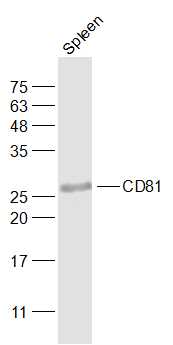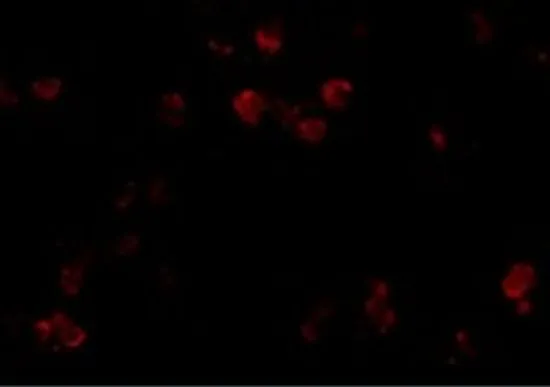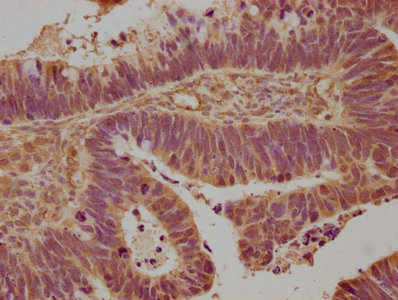![FACS analysis of human peripheral blood lymphocytes using GTX43505 CD81 antibody [1D6]. FACS analysis of human peripheral blood lymphocytes using GTX43505 CD81 antibody [1D6].](https://www.genetex.com/upload/website/prouct_img/normal/GTX43505/GTX43505_2992_FACS_w_23060820_314.webp)
FACS analysis of human peripheral blood lymphocytes using GTX43505 CD81 antibody [1D6].
CD81 antibody [1D6]
GTX43505
ApplicationsFlow Cytometry, ImmunoFluorescence, ImmunoPrecipitation, Western Blot, ELISA, ImmunoCytoChemistry, ImmunoHistoChemistry, ImmunoHistoChemistry Paraffin
Product group Antibodies
TargetCD81
Overview
- SupplierGeneTex
- Product NameCD81 antibody [1D6]
- Delivery Days Customer9
- Application Supplier NoteWB: 1:100-1:1000. ICC/IF: 1:100. IHC-P: 1:100. FACS: 1/5-1/10. *Optimal dilutions/concentrations should be determined by the researcher.Not tested in other applications.
- ApplicationsFlow Cytometry, ImmunoFluorescence, ImmunoPrecipitation, Western Blot, ELISA, ImmunoCytoChemistry, ImmunoHistoChemistry, ImmunoHistoChemistry Paraffin
- CertificationResearch Use Only
- ClonalityMonoclonal
- Clone ID1D6
- Concentration1 mg/ml
- ConjugateUnconjugated
- Gene ID975
- Target nameCD81
- Target descriptionCD81 molecule
- Target synonyms26 kDa cell surface protein TAPA-1; CD81 antigen; CD81 antigen (target of antiproliferative antibody 1); CVID6; S5.7; TAPA1; tetraspanin-28; TSPAN28; tspan-28
- HostMouse
- IsotypeIgG1
- Protein IDP60033
- Protein NameCD81 antigen
- Scientific DescriptionThe protein encoded by this gene is a member of the transmembrane 4 superfamily, also known as the tetraspanin family. Most of these members are cell-surface proteins that are characterized by the presence of four hydrophobic domains. The proteins mediate signal transduction events that play a role in the regulation of cell development, activation, growth and motility. This encoded protein is a cell surface glycoprotein that is known to complex with integrins. This protein appears to promote muscle cell fusion and support myotube maintenance. Also it may be involved in signal transduction. This gene is localized in the tumor-suppressor gene region and thus it is a candidate gene for malignancies. Two transcript variants encoding different isoforms have been found for this gene. [provided by RefSeq, Jul 2014]
- Storage Instruction-20°C or -80°C,2°C to 8°C
- UNSPSC12352203
References
- Size and Concentration of Extracellular Vesicles in Pancreatic Juice From Patients With Pancreatic Ductal Adenocarcinoma. Nesteruk K et al., 2022 Feb 18, Clin Transl GastroenterolRead more
- Colorectal Cancer Cell-Derived Small Extracellular Vesicles Educate Human Fibroblasts to Stimulate Migratory Capacity. Clerici SP et al., 2021, Front Cell Dev BiolRead more
- Umbilical Cord Mesenchymal Stromal Cell-Derived Exosomes Rescue the Loss of Outer Hair Cells and Repair Cochlear Damage in Cisplatin-Injected Mice. Tsai SC et al., 2021 Jun 22, Int J Mol SciRead more
- Extracellular Vesicles from Caveolin-Enriched Microdomains Regulate Hyaluronan-Mediated Sustained Vascular Integrity. Mirzapoiazova T et al., 2015, Int J Cell BiolRead more
- Epidermal growth factor receptor localized to exosome membranes as a possible biomarker for lung cancer diagnosis. Yamashita T et al., 2013 Dec, PharmazieRead more






